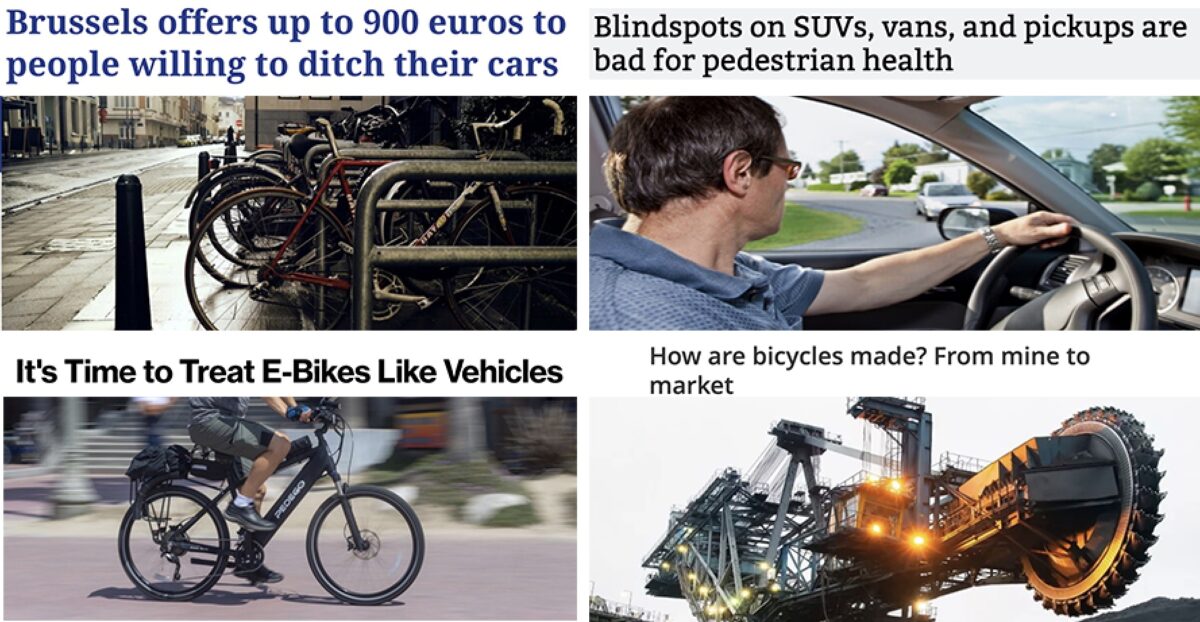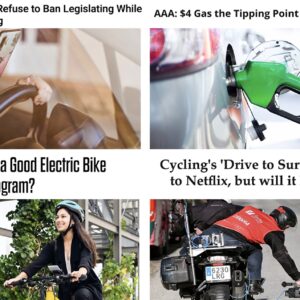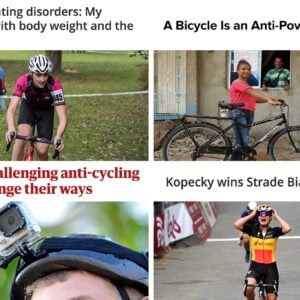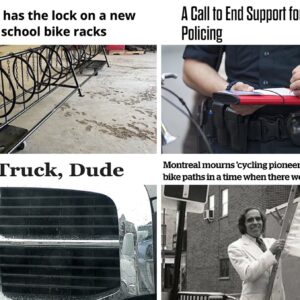Welcome to the week.
Here are the most notable items our writers and readers came across in the past seven days….
The problem with DOTs: This week’s must-read is a Washington Post article that delves deep into the tension between how much power our federal government has (or chooses to exert) over state DOTs, and how too much authority at the state level could prevent us from ever changing the deadly and car-dominated transportation tide.
E-bike boosterism: If you know someone who’s e-bike curious, send them this wonderful article from Hood River resident Megan Ramey where she lays out very compelling reasons to try one.
E-bike silence: Thank god for transportation journalist David Zipper, who is still trying to get elected officials to pay more attention to e-bikes when considering energy policy in the mobility sector.
Pay you to bike: Brussels, the capital of Belgium, will give up to 900 euros ($994 USD) to anyone who cancels their car registration and agrees to purchase bike-related equipment or a bike-share subscription. They call it the “sustainable mobility bonus.”
Advertisement
Cheaper buses: New Zealand will test out an idea to halve the price of bus fare (and leave gas taxes in place) in response to higher gas prices and uncertainty over oil supplies due to the war in Ukraine.
‘Clean mobility for clunkers’: Some Green New Deal advocates and smart policy folks think President Biden should launch a program that allows people to trade in old fossil fuel-powered cars for rebates on e-bike and other EVs.
Where your bike really comes from: A former mining geologist who now writes for Cycling News shares an inside look at the journey your bike takes from the mineral mine to your garage.
What you don’t see can hurt someone else: Thanks to new research on SUV designs from IIHS we are learning more about the link between how the safety of occupants inside cars has come at grave expense to the people outside of them.
What women want: Streetsblog highlighted an interesting new zine from nonprofit Transit Center that gave women in transportation fields a chance to share their voices.
Bike industry and Ukraine: If you’re curious about how major bike companies are responding to the war in Ukraine, don’t miss this excellent roundup from Bicycle Retailer & Industry News.
Thanks to everyone who sent in links this week.








Thanks for reading.
BikePortland has served this community with independent community journalism since 2005. We rely on subscriptions from readers like you to survive. Your financial support is vital in keeping this valuable resource alive and well.
Please subscribe today to strengthen and expand our work.
Strict federal control of how money is spent is only good if it actually meets the needs and desires of each individual state. That is very difficult to do considering how different the needs and desires are for each state.
It is difficult to change what is happening with a state DOT, imagine what level of effort would be needed to change the policies and priority for a federal system.
Disagree with you here, Adam. We already have federal standards for road and highway design, so why not also have some common goals for how federal funds are used?
Whether you drive or roll in Washington, Oregon, or Idaho, you should be just as safe in one state as any other. A state shouldn’t be able to take more federal $$ as more residents – and visitors – die in traffic every year.
Fred, that assumes that the federal common goals are good. Consider the situation where a national administration prioritized electric personal automobiles above everything else (A potentially logical conclusion considering urban sprawl). This hypothetically could mean that all federal funds MUST be spent on widening roads and building more charging stations. That could work well in states and cities where the population density is so low that other form of transit are not realistic. However, that same policy would be very damaging for cities with higher density where cycling and mass transit function better.
The key point is that painting the entire country with a single brush can make it very difficult to paint each state and city properly. More local control can make it easier for the local population advocate for meaningful change.
Maybe low density areas will be late adopters of electric vehicles because the fairly normal practice of driving 300+ miles round trip to pick up parts or look at a bull or whatever just doesn’t work so well with battery power.
The USA has long been a nation where there are an awful lot of bikes per person (~0.3/person) but also where few of these bikes are used for transportation. Will e-bikes be treated differently by ‘murricans? I don’t know. I do, however, suspect that the primary barrier to cycling mode share is not exposure to bikes (or e-bikes) but the ease of driving and the pervasive valorization of driving in our society.
And the weather protection, comfort, range, speed, privacy, and cargo capacity afforded by cars, not to mention safety (perceived and actual), lack of physical effort, usability by a not-completely-overlapping set of people (elderly, handicapped, etc.), theft resistance, ability to carry passengers, and other factors.
Cars are very attractive to a wide range of people for completely legitimate reasons. “Ragers against cagers” often seem to overlook these factors and credit “marketing” and “Fordism” for the reason many (most) people prefer driving.
Regardless of what Amsterdam and Copenhagen lovers claim, bicycling will never replace driving; what we need are new “intermediate modes” that incorporate the attributes of both. Something akin to a large electric bike with a surrounding enclosure and passenger seat, or a small electric car that resembles a bike in some way. Arcimoto (https://www.arcimoto.com/) is on the right track here. Smart Cars were as well. Whether they eventually catch on is a different issue entirely.
Building apartments that are incompatible with anything but cars (which is what happens when you force your residents to park on the street) makes achieving a future different than the status quo more difficult.
“Building apartments that are incompatible with anything but cars (which is what happens when you force your residents to park on the street) makes achieving a future different than the status quo more difficult.”
Can you elaborate on that? I’m not arguing–just not sure what you mean. It sounds like you’re saying that building apartments without off-street parking makes changing the status quo (the reliance on cars) more difficult.
Well, I’m not going to park my fancy electric trike/cargo hauler on the street, and I can’t fit it in my apartment, so… I guess I’ll keep my truck, which is safe to leave on the street and doesn’t need to be charged.
This problem is much easier to solve if my building has a place I can have with access to electricity and some degree of security. Bonus if it’s out of the weather.
In short: street parking only = status quo; access to parking = much easier to try something different.
You’re absolutely correct – for anyone with more than 1 bike and/or bikes in non-standard conformations (my ‘bents, e-bikes, cargo bikes) and/or a girlfriend who will *not* allow you to work on bikes in the apartment (!) there needs to be secure storage at street level for bikes and a work area if you want me to move in. I’ll gladly pay extra for indoor bike storage lockers with ground floor access that can handle a 6+ foot long recumbent.
Bike rooms are simply not an option. They’re accessible to anyone in the complex and I would not feel comfortable with my high-racer with it’s Archer electronic shifter being stored in a semi-public place.
Heck, I wouldn’t be comfortable with my town bike with it’s cheap Tourney 1×7 drivetrain stored there – last thing I want to do is find my bike un-rideable when I leave for work.
At the moment I typically look for places with rentable garages or (1 place that’s on my radar as the current occupant may leave at the end of term when he graduates) with a lockable Tough Shed or some such.
Transit had many of these characteristics (and was mostly electrified in urban areas) but the manufactured consent of Fordism created a new system where the pursuit of profit caused pollution, safety, equity, rational land use, and ecological sustainability to become seen as barriers to “progress”. Fordism also normalized the pathological stress and anxiety of driving for which there was no equivalent in a well-managed transit system.
Transit is not point-to-point, on demand, or available in off-hours or to “non-standard” locations. Transit is a huge hassle if you have stuff.
And transit has acquired certain other characteristics that have completely disqualified it for many riders. As stressful as driving is, at least I know I won’t be stabbed or get a deadly infection or have to deal with someone staring at my wife and arguing with god.
I believe the 19th century transit model is dead.
The fixed-route system that you use on TriMet buses are as you describe them, but all cities that get federal subsidies must also offer point-to-point on-demand paratransit (AKA lift or dial-a-ride) service for its disabled customers which often go to “non-standard” locations, which TriMet both offers and subsidizes other agencies and companies for their services. In addition, the feds and most states subsidize rural public flexible-transit system services that follow a general route, but allow for pre-determined deviations on the routes (when a customer calls ahead).
I’m pretty sure that Watts is thinking about how TNCs are cannibalizing transit in cities (at least for the people who can afford them). I should also note that “market urbanists” have been among the biggest boosters of TNCs because they make the “car free” life more convenient (no need to own a car if you can take an Uber SUV).
I am pretty sure the future of transportation, public and private, is robot taxis, for better or worse. I think better, but we’ll find out.
I stand corrected: Robotic Google SUVs.
With virtual entertainment systems and a Jacuzzi.
PS I should have written “Building apartments that are incompatible with anything but gasoline powered cars” because it is currently difficult/highly inconvenient to charge a vehicle without a dedicated place to park/charge it.
Thanks–makes sense.
In much of the cold northern plains, outside plugs are the norm at apartment complexes, to plug in engine block heaters for those -20 nights.
But are available only to parking on-premise/within the complex, not street parking, right? That’s not relevant to Portland, but is akin to the barriers to weaning ourselves from fossil fuels we erect when we dump all our parking onto the street.
It is relevant to those parts of Portland that were annexed after the county required all apartments to have an excess of off-street parking (pre-1991) and banned on-street parking on all arterial roadways. It was only after annexation that the City allowed for on-street parking by taking away travel lanes (outer Division and 122nd used to be 3 lanes in each direction). Even then, much of the on-street parking space remains largely unused. Over 40% of the city’s population live in those “irrelevant” parts of town such as East Portland, SW, Cully, and Brentwood-Darlington, including most of the poor, immigrants, and visible minorities.
…theft resistance… I’m laughing to keep from crying. In my circle of acquaintance 3 personal cars have been stolen, one was recovered in passable condition but two were so whipped they were totaled. Car theft has cost my business over $5000.00 and a lot of aggravation. Bikes of any description are easier to store than cars.
I come from a land where distances between the most common destinations are 10-50 miles, and most people won’t cycle for about half the year due to winter. Having grown up driving everywhere, those legitimate reasons you mentioned are not lost on me, yet I “rage against cages” all the time despite sometimes still driving autos and living among a family that drives all the time, without insulting them for it.
But I look at my family and community and think most people overlook the results of their auto dependency, most of all their dwindling health and resiliency. I also recognize the strength and resiliency that allows me to pedal long distances and through cold, high-wind days came from simply never giving up cycling, whereas most people around here quit cycling once they can legally drive. Many hunters will sit still for hours waiting to shoot an animal, but still think I’m crazy for pedaling less than a mile through snow. Many folks think they couldn’t pedal a bike a mile, though they may walk that far in their work day.
I mention all that, because I think you overlook the power advertisement, marketing, propaganda, etc have had over shaping our thoughts and society. So far as I can see, the US is exceptional in so many of the worst ways mostly because of those things. Ads can be the tipping factor in people’s decision making. Ads can linger in minds and shift self esteems. The ways people consume such things, respond to them, and witness each other’s related behavior can turn into feedback loops that change or reinforce cultures. Companies wouldn’t invest millions in advertising if it wasn’t effective. The CIA wouldn’t have an Entertainment Liaison Office if PR weren’t effective. Edward Bernays would have had no career if the public was resistant to such manipulations. People wouldn’t walk into my shop looking for certain brands if advertisement was as benign as you seem to think.
Our country might have actually ensured high quality public transit would exist if our government and corporate entities didn’t push, through propaganda of all sorts, individualistic consumption in the Cold War and beyond. We might not need bicycling to replace driving completely, but bicycling could replace most trips if people could shift their thinking a little bit and try it out with determination in the face of initial struggle, some support from experienced people, and infrastructure and policy developments that would secure their rides.
Rage all you want — my point was that in order to make smart choices about transportation policy, you need to understand why people do what they do. Cars are great for a lot of reasons, and also have some terrible aspects to them. If you believe that people only drive because they’ve been bamboozled by slick marketing, you’ll have a hard time understanding why people won’t change their ways after you’ve “educated” them.
Though I have a car, I very rarely drive. I don’t talk the talk, but I do walk it.
I’m with you in agreeing one should understand the people they govern, but you severely misunderstand if you think I believe marketing is the only (or even primary) reason people drive. Seems to me you didn’t read my first paragraph with care. Also, I can do without your patronizing suggestion that I seek to “educate” (whatever that means to you in quotation marks) people. I’ll share my experience and/or current understanding, but I won’t assume it will be news or old hat to anybody.
Also, since you mentioned the raging, I’d like you to know my raging against automobile use consists of pointing out how poorly most people drive, suggesting our climate and vulnerable road/path/sidewalk users would be far better off if we eliminated unnecessary auto trips, and at my most drunken belligerence, hyperbolically telling my very close brother who bought a small SUV a couple years ago that nobody should drive (a perspective to which he’s agreeable; he really likes cycling, too). I’m not against people who drive, I don’t threaten anybody who does, and I don’t threaten anyone’s auto.
With Ukraine & oil prices…its time to make fixed route transit free for active riders: For all too many US transit agencies the collection of local bus fares is more a political tool (showing drivers that bus riders are not getting a ‘free ride’) and or a method for controlling access to transit areas…as the fare box income can be very minimal (especially after deducting costs to collect, audit and impact on dwell time at stations). A good local example is CTRAN, as they collected 1.4% of operating revenues from their fare-box during 2022.
Most people with alternatives are not avoiding transit because of the price. Making transit free might even reduce ridership among those who have a choice.
TriMet is basically free on the trains already with little to no enforcement and look how crappy they are now.
Can’t imagine how much worse it’d get if it was completely free.
Maybe if people were required to behave civily, and those that didn’t tossed off the bus/train, then I MIGHT be ok with a free transit system.
I’m a bit sad to say I agree with you, Solar. Keeping the indigent *off* public transit is the real benefit of fares. If you make it free, it becomes so crappy, scary, and unsafe that no one but the crazies will ever use it.
Though “indigent” do make up a good portion of the trouble makers, there’s been a few suit wearing business people obviously coming from a bar that weren’t the paragons of civility towards their fellow passengers and would have been prime canidates for being tossed off the train . . . while moving . . . oh wait, did that slip out?!? oops. /s
Great article about the source material for bike frames, particularly for titanium.
State DOTs are the heart of the highway industrial complex. Federal funding has enabled this but at present all they know is designing roads, their friends build roads, and their clientele operate motor vehicles.
The debate over freeways and the I-5 bridge, a debate enforced by DOT intransigence, is a distraction from what may be the most important earthquake-prone bridges in Portland. The Steel Bridge is a bottleneck for transit with the potential to split the light rail system in half. Even on a good day it throttles heavy rail traffic with tight radius turns so that train speed is limited all up and down the Eastside. Level crossings become a nuisance to local travel and make a hash of several bus schedules.
Lacking the Steel Bridge after a quake, Portland’s rail network would be in shambles. There might be other issues but that one stands out. As the sea level rises the port might have renewed importance and it would be a bad time to be holding a pair of broken railroad bridges.
I’m not ignoring the ownership of the bridges. Clearly the legacy railroads have an interest in maintaining them and there’s not much sentiment for giving them a present. However if it’s clear that the city and state government are at least in cooperation that would go a long way in advancing the goals of both.
I’m wondering if Bike Portland is going to take up the coverage of the Portland Clean Energy Fund and recent audit issues/dismissal of staff over the administration. Awhile back JM was critical of coverage where Steve Novick and Angus Duncan were asking for greater controls and benchmarks for the program. Seems like recent Oregonian coverage has shown that their suggestions were timely and appropriate and should have been taken more seriously.
The PCEF is a relevant issue for the upcoming city elections. I’m wondering if there’s a reason why discussion of the PCEF has gone away on this site.
VS,
Thanks for the story idea. I’ve been watching the information come out and will consider coverage.
– Jonathan (on vacation!)